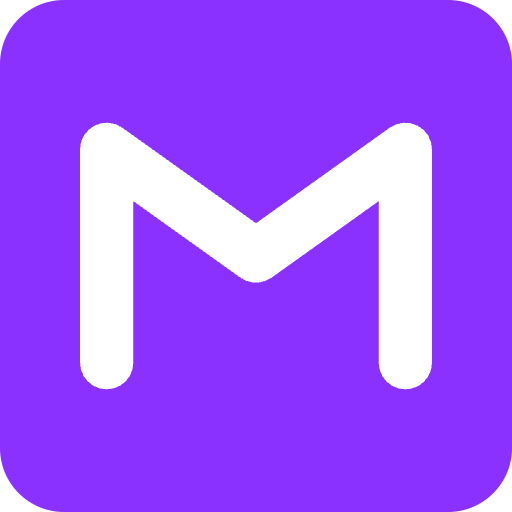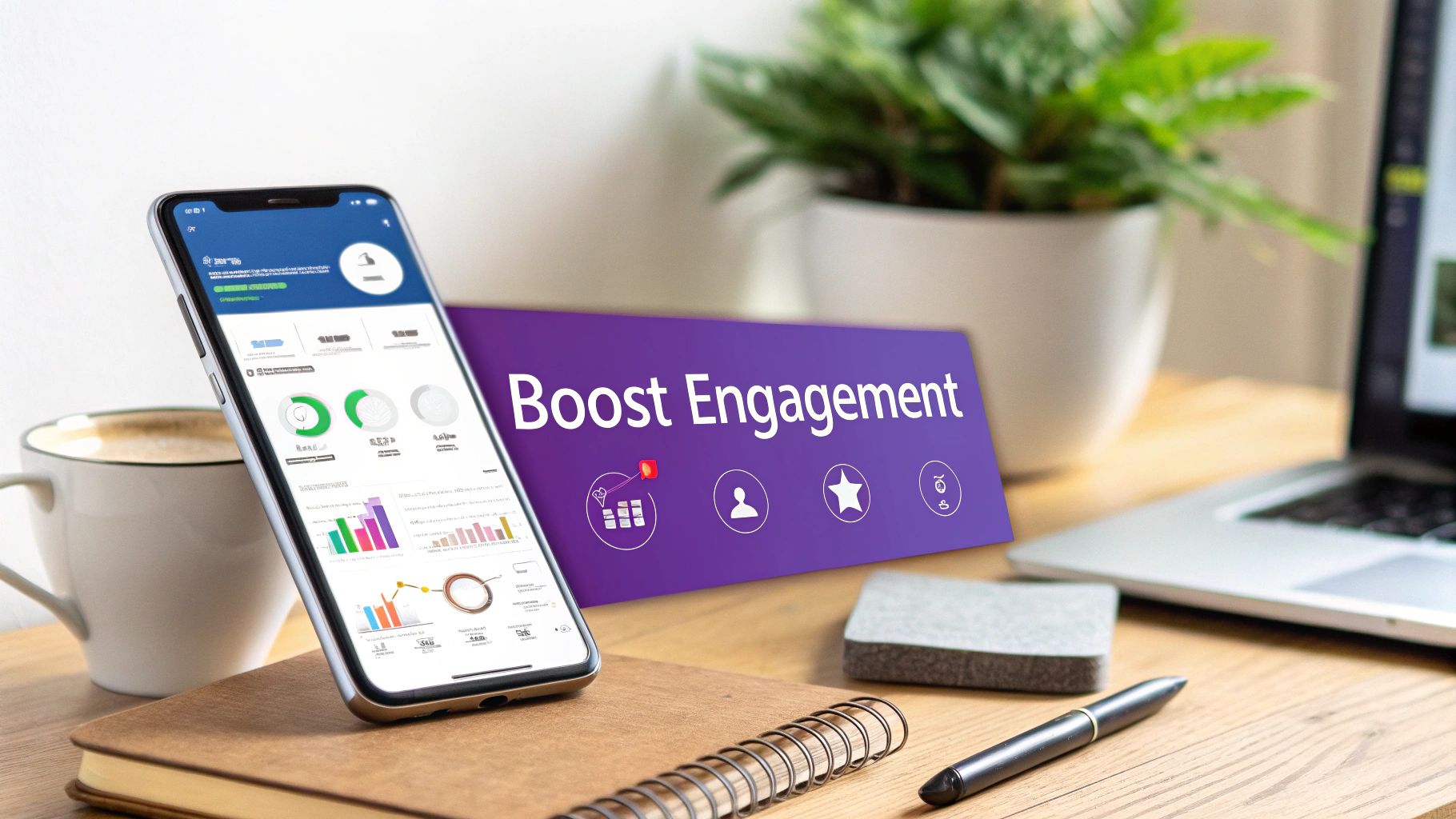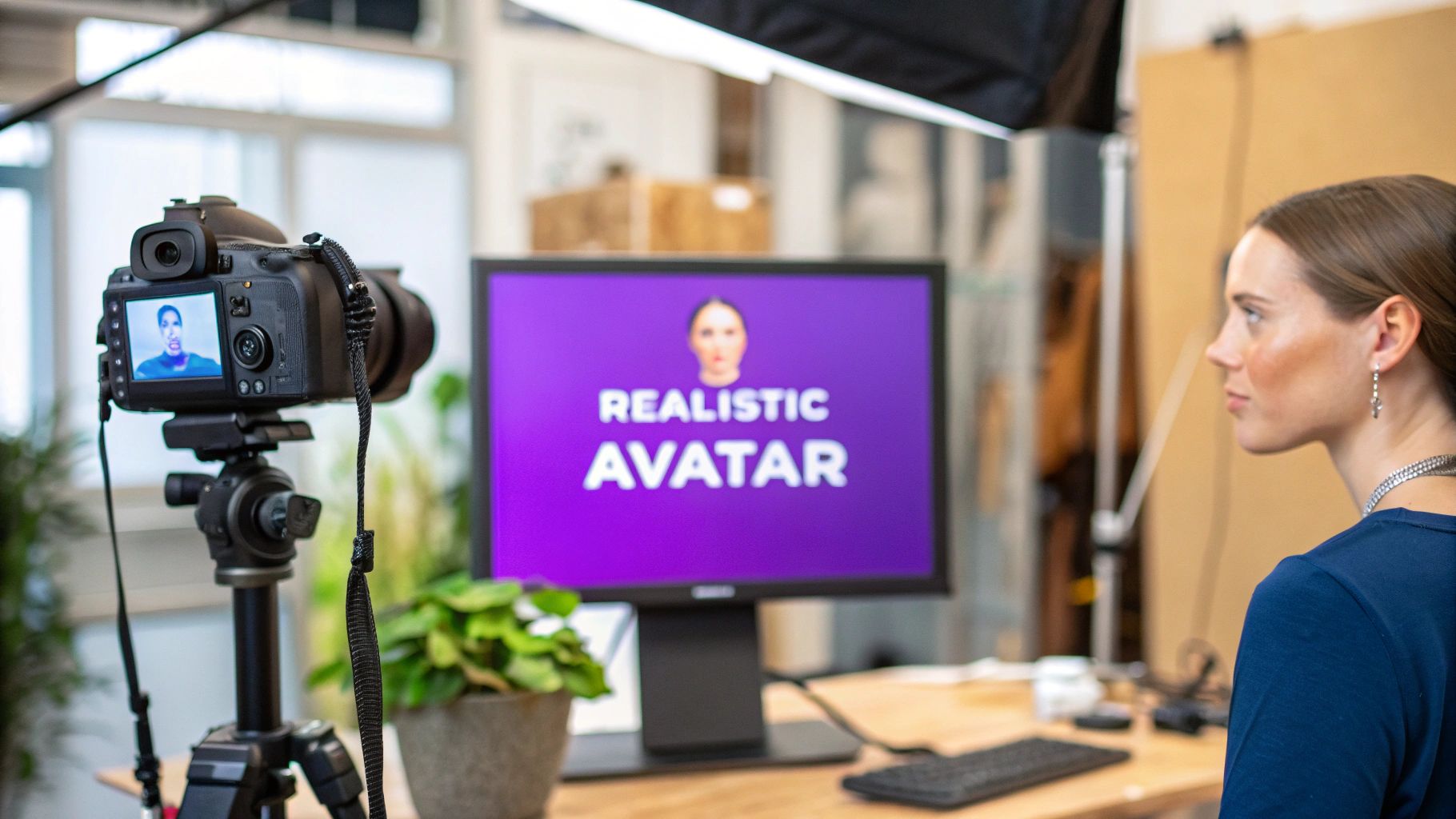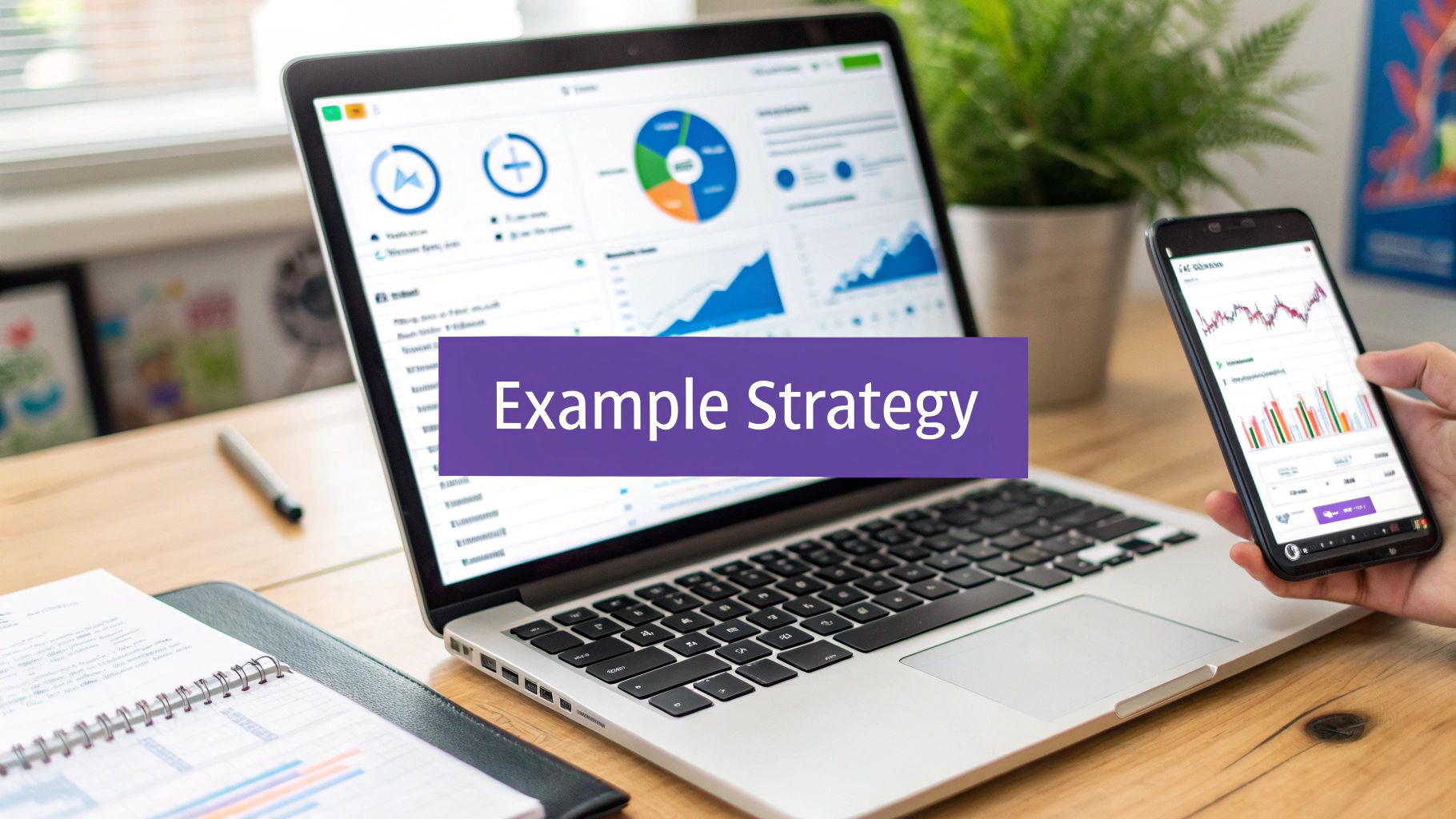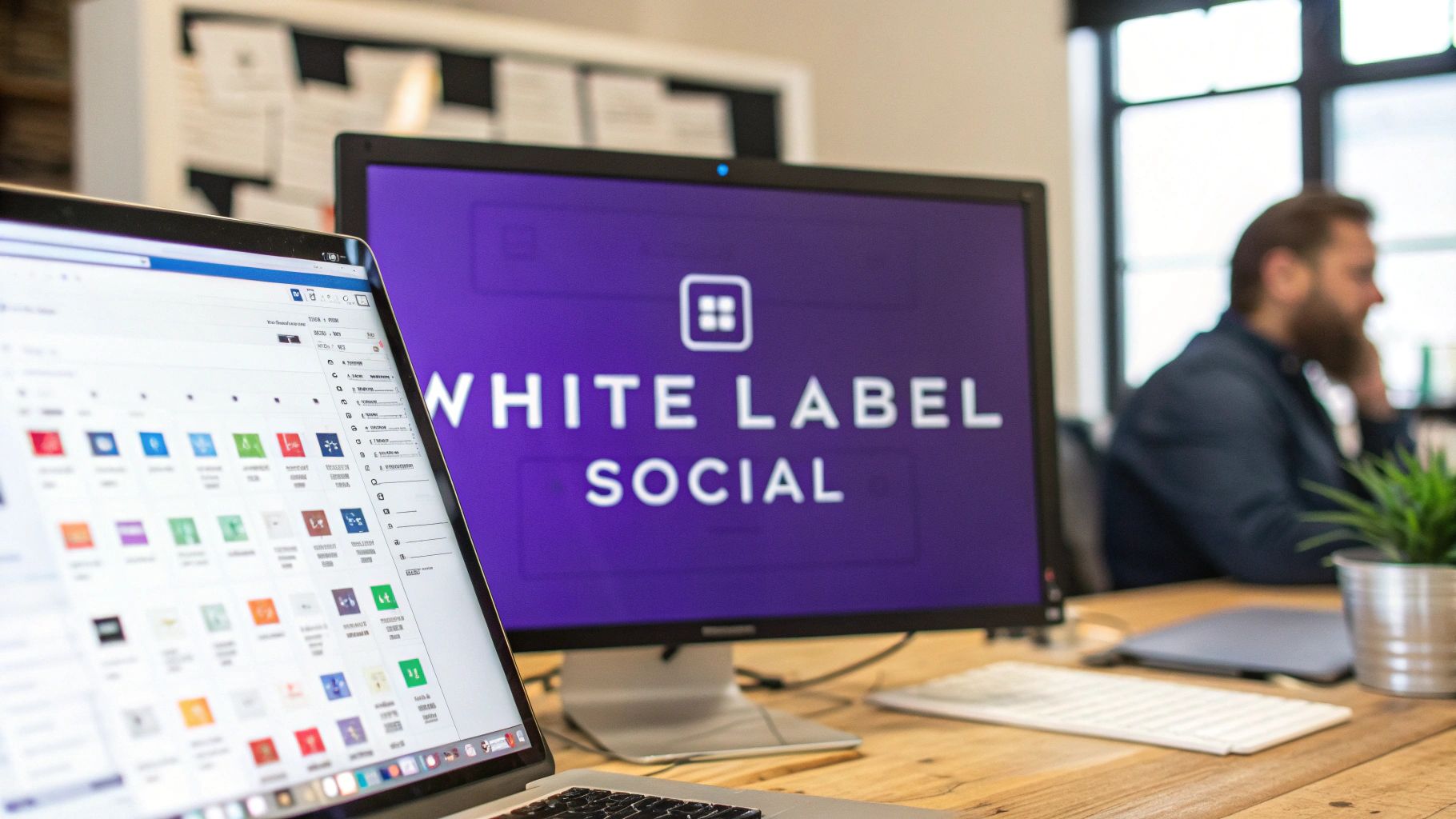Personal Branding Online: Boost Your Digital Identity Today

Why Your Digital First Impression Matters More Than Ever

Long before you join a video call or shake a hand, your online presence has already made an introduction. It acts as your silent representative, working around the clock to shape how people see you professionally. Think of it as the cover of your career story—it either draws people in or makes them put you back on the shelf. This split-second judgment can influence everything from job offers to new partnerships.
This is a major change from the days when a firm handshake and a business card were all you needed. Today, your digital footprint is your new handshake. That’s why a thoughtful approach to personal branding online is no longer a "nice-to-have." It’s about clearly showing your true professional value, not about creating a fake persona or just listing your wins. Authenticity builds trust, and trust is the bedrock of any solid professional relationship.
When you share what you genuinely know—your unique perspective and even your learning process—you forge connections that feel real. This turns self-promotion into something genuinely helpful for others, making you a trusted resource instead of just another voice in the crowd.
The Misconception of Self-Promotion
A common reason professionals avoid building their brand online is the fear of seeming arrogant. Many think personal branding is just bragging, but that’s a big misunderstanding. Great personal branding online is about being generous with your knowledge. It’s about asking, "How can my experience help my network?" not, "How can I impress everyone?"
Think about these simple shifts in perspective:
- Instead of just listing your achievements, share what you learned from them.
- Rather than just announcing a promotion, document the journey and your goals for the new role.
- Instead of saying you have a skill, show it by solving a common industry problem in a post or article.
This change in focus from "look at me" to "let me help you" is what makes a personal brand truly effective. It builds a reputation based on helpfulness and competence, which naturally attracts opportunities to you.
The Surge in Digital Identity
The idea of personal branding isn't new; it started gaining steam with Tom Peters' 1997 article, 'The Brand Called You.' But its importance has exploded with the growth of social media. The data shows it, too: Google searches for "personal brand" have increased more than 4 times in recent years, highlighting a clear global trend.
Professionals everywhere now see that a well-managed digital identity is essential for career growth. You can explore more on this in these personal branding statistics. This isn't just a passing fad; it’s a direct response to how we make decisions and build connections in today's world.
Building Your Digital Identity From The Ground Up
Creating a strong digital identity is a lot like building a house from a detailed blueprint. Before a single brick is laid, an architect knows exactly what each room will be used for. In the same way, your personal branding online requires a clear plan. Without one, you risk building a confusing and disjointed presence that leaves your audience scratching their heads. The goal is to create a digital world where your LinkedIn profile, social media posts, and personal website all tell the same, authentic story about who you are and the value you bring.
This journey starts with looking inward, not just broadcasting outward. First, you need to pinpoint what makes you uniquely valuable. Go beyond your job title or degrees. What problems do you love to solve? What fresh perspective do you offer in your industry? This is your unique value proposition—the core message that will be the foundation for everything you create.
Defining Your Brand's Core Components
Once you’ve uncovered your core message, you can begin to shape the look and feel of your brand. This isn't about creating a fake persona; it's about amplifying your authentic self. This includes developing a consistent tone of voice. Are you witty and informal, or are you more authoritative and direct? It also involves your visual identity, like your profile picture, color palette, and even the fonts you choose. Consistency across these elements makes your brand recognizable and helps build trust with your audience.
For example, a graphic designer might use a vibrant, creative visual style on Instagram to show off their portfolio. On LinkedIn, they might adopt a more polished, case-study-focused approach. The core brand message—creativity and professional expertise—is the same, but the delivery is tailored to each platform. This blend of consistency and adaptation is crucial. A strong brand feels genuine, not forced, because it’s built on real strengths and passions.
The Impact of Brand Elements Across Platforms
Different online platforms are designed to highlight different parts of your personal brand. What makes a great impression on a professional network might fall flat on a visual-first social app. Knowing how to adjust your core message for each space is essential for effective personal branding online.
To help you strategize, this table breaks down how key brand elements play out on different platforms.
Core Elements of Online Brand Identity
Comparison of essential brand components and their impact on different platforms
| Brand Element | LinkedIn Impact | Instagram Impact | Professional Website | Priority Level |
|---|---|---|---|---|
| Professional Headshot | High - It’s your first handshake, establishing credibility and approachability. | Medium - Important for your profile, but in-feed visuals often take center stage. | High - A cornerstone of your 'About' page that builds trust. | High |
| Written Bio/Summary | High - This is the main stage for declaring your value proposition and expertise. | Medium - Space is tight, so your message must be punchy and engaging. | High - Crucial for search engine optimization (SEO) and making a strong first impression. | High |
| Tone of Voice | Medium - Professionalism is the baseline, but injecting personality helps you stand out. | High - Your tone directly shapes your community and how you connect with followers. | Medium - Should align with your industry's standards and your target audience's expectations. | Medium |
| Visual Style (Colors, Fonts) | Low - The platform's design is fixed, limiting your visual control. | High - Absolutely critical for brand recognition and creating an appealing aesthetic. | High - You have complete control to express your unique brand identity. | Medium |
Ultimately, a strong headshot and a well-written bio are your highest priorities because they make an immediate impact on professional platforms like a LinkedIn profile or your personal website.
Building your digital identity is an exercise in strategic self-awareness. It’s about translating your genuine strengths into a consistent and compelling story that connects with your target audience, turning your online presence into one of your most powerful career assets.
Turning LinkedIn Into Your Professional Growth Engine
While other platforms are great for eye-catching visuals or quick updates, LinkedIn is the undisputed headquarters for professional growth. Thinking of it as just a digital resume is like using a smartphone only to make calls—you're missing out on its most powerful features. The real magic happens when you transform LinkedIn from a static profile into a dynamic engine that creates opportunities, builds authentic relationships, and defines career moments.
Effective personal branding online on this platform isn't about shouting your achievements from the rooftops. It's about showing your value through consistent, meaningful engagement. It's the place to demonstrate your expertise, share your perspective, and join the conversations shaping your industry.
Beyond the Profile: Strategies for Genuine Engagement
A complete profile is your ticket to the game, but it's not how you win. Real visibility comes from being an active participant in the LinkedIn community. This means going beyond just collecting connections and starting to build real relationships through thoughtful interactions.
A great way to start is by creating content that solves problems. Instead of just posting about a promotion, write about the single biggest lesson you learned on the way to earning it. This shift from announcing to explaining gives your network something truly valuable. Here is a simple framework you can use:
- Share Insights, Not Just News: When you post an industry article, add a few sentences with your own take. What does this development mean for your field's future?
- Ask Engaging Questions: End your posts with open-ended questions that spark discussion. This shows you're looking for a conversation, not just making a speech.
- Comment with Substance: Ditch the generic "Great post!" and add to the dialogue. A comment like, "This is a great point. I saw this in action when we tried to implement X, and the result was Y," adds value and highlights your experience.
This strategy turns your activity feed into a living portfolio of your knowledge. The platform's algorithm also rewards this type of genuine interaction, boosting the visibility of your content and profile.
Consistency Is Your Greatest Asset
Building a professional reputation on LinkedIn is a marathon, not a sprint. A few posts here and there won't create the momentum needed to become a recognized voice. Consistency is what separates the passive profiles from the influential ones. The data backs this up: top creators are highly active. In fact, 72% of LinkedIn creators post at least every two days, and 20% post daily. This frequent activity is a key part of their brand strategy, as detailed in these valuable insights on LinkedIn branding.
This screenshot shows a standard LinkedIn feed, where posts from creators you follow appear next to professional news and company updates.

The main takeaway here is that your content is in direct competition for attention with established industry leaders, making consistent, high-quality posts vital for getting noticed.
This doesn't mean you need to dedicate hours each day to content creation. Tools like MakerBox can help you brainstorm ideas and even draft posts, making it much simpler to keep a steady presence. The goal is to establish a dependable rhythm that keeps you top-of-mind with your network, turning your LinkedIn profile into a powerful asset for your career.
Mastering Visual Storytelling That Builds Real Connections
While a platform like LinkedIn acts as the professional boardroom for your personal brand, visual platforms such as Instagram are more like the relaxed, after-hours networking event. This is where you can go beyond job titles and resumes to build genuine connections by sharing the human side of your work. Strong personal branding online on these platforms isn't about posting flawless selfies; it's about strategically telling your professional story through compelling visuals, forging an emotional link that text alone often can't.
Think of it as the difference between telling someone what you do and showing them. A financial advisor could share a Reel of their behind-the-scenes prep for a client workshop. A software developer might post a carousel of simple diagrams to explain a tricky coding concept. These visuals make your expertise more accessible and relatable, transforming your brand from a static resume into a dynamic, living story. The goal is to blend professional insights with personal touches, creating a brand that feels both highly skilled and genuinely human.
The Power of Visual-First Platforms
Visual platforms have fundamentally changed how personal brands are built. Instagram, in particular, has become a major force, now boasting 2 billion monthly active users worldwide. Its reach is undeniable, especially when you consider that 82% of all social media users have an Instagram profile. This huge audience offers a chance to connect with people on a more personal level, showing them the person behind the profession. You can find more details in this thorough social media statistics report. This isn’t just about sharing attractive pictures; it’s about using visual media to amplify your knowledge and cultivate a community.
Balancing Professionalism with Personality
One of the biggest hurdles professionals encounter on visual platforms is finding the right balance between credibility and personality. It can feel like a tightrope walk, but the key is to ensure all your content aligns with your core brand message. The aim is to create a unified experience that feels authentic everywhere, even if the tone adjusts slightly from one platform to another.
Here’s how you can adapt the same content idea for different platforms while staying true to your brand:
| Content Idea | LinkedIn Approach (Professional Focus) | Instagram Approach (Visual Storytelling) |
|---|---|---|
| Project Completion | A detailed text post about the project's goals, challenges, and outcomes, tagging team members and the client. | A carousel post with high-quality photos of the final product, behind-the-scenes video clips, and a caption that tells the project's story. |
| Attending a Conference | A summary post sharing the top three takeaways from a session, sparking a professional discussion. | A series of Instagram Stories with short video clips from the event, a photo with another attendee, and a poll asking what your followers want to learn. |
| Sharing Expertise | A long-form article or text post explaining a complex industry trend with data and in-depth analysis. | An infographic or a short, animated Reel that breaks down the same idea into simple, digestible visual points. |
This table illustrates how a single professional activity can be presented in distinct ways. On LinkedIn, the focus is on detailed, text-driven analysis. On Instagram, the emphasis shifts to visual appeal and quick engagement. By mastering this cross-platform adaptation, you can broaden your reach and strengthen your personal branding online without compromising your professional integrity. You’re the same authentic professional, just speaking a different dialect for a different room. This approach builds a multi-dimensional brand that resonates more deeply and creates connections that turn into real opportunities.
Creating Content That Actually Builds Your Reputation
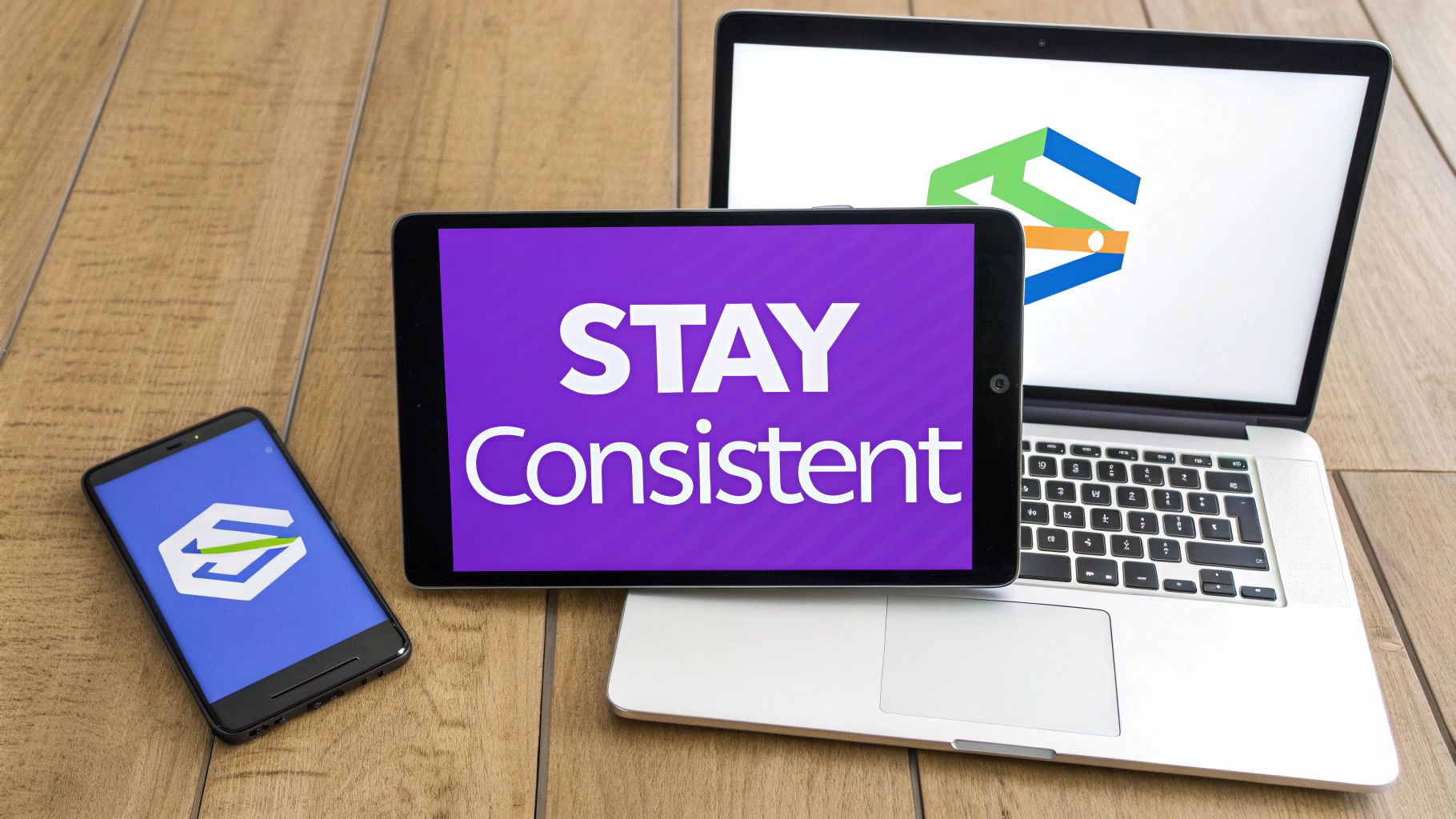
Great content is the engine for your personal branding online, but many people miss its true purpose. It’s not about broadcasting your achievements; it’s about sharing your expertise in a way that genuinely helps others. Think of yourself as a teacher first. Your goal is to turn your specialized knowledge into clear, valuable insights that solve real problems for your audience. This is how you naturally become a go-to expert.
This mindset shift from "look what I did" to "here is how you can do it" is critical. Instead of just listing your skills, you demonstrate them. For example, a project manager could write a post on a simple framework for managing scope creep. A data analyst might create a short video explaining how to interpret a confusing metric. This approach builds a reputation based on helpfulness and competence, attracting better opportunities.
Choosing Content Frameworks That Connect
The most successful personal brands don’t just post content on a whim; they use proven frameworks that mix educational value with a personal touch. Your content strategy should focus on answering the questions your audience is already asking. One of the most effective approaches is to build content around your unique perspective on common industry challenges.
Consider these high-impact content ideas:
- How-To Guides: Break down a complex process into simple, actionable steps. This format is incredibly useful and highly shareable.
- Mistake Analysis: Share common errors you see in your field and explain how to avoid them. This positions you as an experienced mentor.
- Personal Case Studies: Detail a project you worked on, focusing on the problem, your process, and the results. This offers concrete proof of your skills.
- Contrarian Takes: If you have a counterintuitive opinion on a popular topic, explain your reasoning. This sparks conversation and shows you’re a critical thinker.
A structured approach like this makes content creation sustainable. Instead of wondering what to write next, you have a repeatable system for generating ideas that reinforce your expertise. The aim is to become a reliable source of wisdom, not just another voice adding to the noise.
The Impact of Different Content Types
Just as you would adjust your message for different social platforms, you should also pick content formats that match your branding goals. Some formats are better for quick engagement, while others are designed to build deep authority. Understanding this difference helps you invest your time where it will have the greatest effect on your personal branding online.
The table below offers an analysis of different content formats and their effectiveness for building a personal brand.
Content Types and Their Branding Impact
Analysis of different content formats and their effectiveness for personal brand building
| Content Type | Engagement Rate | Authority Building | Time Investment | Best Platforms |
|---|---|---|---|---|
| Long-Form Blog Posts | Medium | High | High | Website, LinkedIn |
| Short-Form Video (Reels/Shorts) | High | Medium | Medium | Instagram, TikTok, YouTube |
| Text & Image Posts | Medium | Low | Low | LinkedIn, X (Twitter) |
| Carousel/Infographic | High | Medium | Medium | Instagram, LinkedIn |
| In-Depth Guides/eBooks | Low | Very High | Very High | Website (Lead Magnet) |
As the table shows, formats like long-form articles and eBooks are powerful for establishing authority but demand a significant time commitment. On the other hand, short-form video drives high engagement and is perfect for reaching a wider audience quickly. A balanced content strategy mixes these formats, often repurposing one core idea—like a detailed blog post—into a carousel, a video, and several text-based posts. This approach maximizes your reach without causing burnout.
Essential Tools That Make Brand Management Actually Manageable
Building a strong online presence for your personal brand is a lot like running a small business—you need the right tools to work smarter, not harder. Without them, you’re left doing everything by hand, which is a fast track to burnout. A good mix of platforms can help automate, schedule, and analyze your branding efforts, turning a huge task into a manageable system. The idea isn’t to use every tool out there, but to assemble a lean, effective toolkit that fits your needs and budget.
This means finding a balance between content creation aids, scheduling software, and analytics dashboards. Many professionals start with free or low-cost resources and invest in more advanced solutions as their brand grows. Building a powerful personal brand is a marathon, and your toolkit should be designed to support you for the long run.
Content Creation and Scheduling
Consistently creating and sharing quality content is the backbone of any successful online brand. However, we've all stared at a blank screen, wondering what to post next. This is where modern platforms can be a real game-changer, helping you generate ideas and keep a steady stream of posts flowing.
- Content Ideation: Tools can help you brainstorm topics that your target audience actually cares about, ensuring your content calendar is never empty.
- Scheduling: Planning your content ahead of time is a lifesaver. Scheduling tools let you create posts in batches and set them to publish automatically, keeping your online presence active even when you're busy.
- Visuals: In today's visual world, great images are a must. Tools that help you design graphics or improve your professional headshot make sure your brand looks sharp and cohesive everywhere.
Emerging Platforms for Brand Growth
Beyond the usual schedulers and design apps, a new wave of all-in-one platforms is making brand management even simpler. These tools combine multiple functions—from content generation to profile optimization—into a single, easy-to-use dashboard. One such platform is MakerBox, which uses AI to help professionals build a more compelling online identity.
For instance, platforms like these can help you write optimized social media bios, generate post ideas, and even design profile visuals that match your personal brand.
This screenshot from MakerBox shows how it can help you build your social media presence with AI-powered tools. This approach offers a clear benefit: it pulls the technical and creative parts of personal branding online into one accessible place.
When picking your tools, think about the learning curve and time you'll need to invest. Start small with one or two platforms that solve your biggest headaches. As you get more comfortable, you can expand your toolkit. Remember, the best tools are the ones you’ll actually use to build and sustain your brand’s momentum. A well-chosen toolkit doesn’t just save time; it empowers you to be more strategic and effective with your online presence.
Your Personal Branding Action Plan That Actually Works
Turning what you know into real results requires a clear roadmap. Think of building a strong personal brand like climbing a mountain—it looks overwhelming from the base, but you can conquer it by taking one small step at a time. This action plan breaks down the journey into simple phases, guiding you from strategy to long-term growth.
Phase 1: Brand Strategy and Infrastructure
Before you even think about creating content, you need a solid foundation. This first phase is all about deciding on your direction and putting the essential pieces in place. It ensures your efforts are focused and effective from the very beginning.
- Define Your Niche: Get specific. Instead of calling yourself a "marketing expert," narrow it down to "B2B SaaS content strategist for startups." A tight focus makes you much easier to find and remember.
- Identify Your Target Audience: Who are you trying to connect with? Be precise. Think about their job titles, the problems they need to solve, and the online platforms where they hang out.
- Establish Your Home Base: Your personal branding online needs a central hub. This is usually a polished bio page on your company site or a simple personal website. Make sure it has a professional headshot, a clear bio, and links to your social profiles.
- Optimize Social Profiles: Pick one or two platforms where your audience is most active and fill out your profiles completely. For most professionals, a complete LinkedIn profile is a must-have.
Phase 2: Content Creation and Engagement
With your foundation set, it’s time to start sharing what you know. Consistency is the single most important factor in this phase. The aim is to become a trusted and helpful voice in your niche, building a reputation for being generous with your knowledge.
- Create a Content Calendar: Plan your topics a month ahead. Aim for a mix of formats like short-form video, text posts, and image carousels. This takes the daily stress out of figuring out what to post.
- Engage Authentically: Set aside 15 minutes every day to interact with others. Leave thoughtful comments on posts from industry leaders and peers. Answering questions and joining conversations helps you build real relationships.
- Share Your Perspective: Don’t just repost an article; add your unique take. A simple addition like, "Here’s what this means for our industry..." can transform a basic share into a piece of thought leadership.
Phase 3: Monitoring and Growth
Building a brand isn't something you set up once and then forget. You need to regularly check your progress to see what’s working and what needs tweaking. This data-driven approach ensures your efforts continue to produce results.
This infographic shows a simple three-step process for tracking your brand's growth and impact.
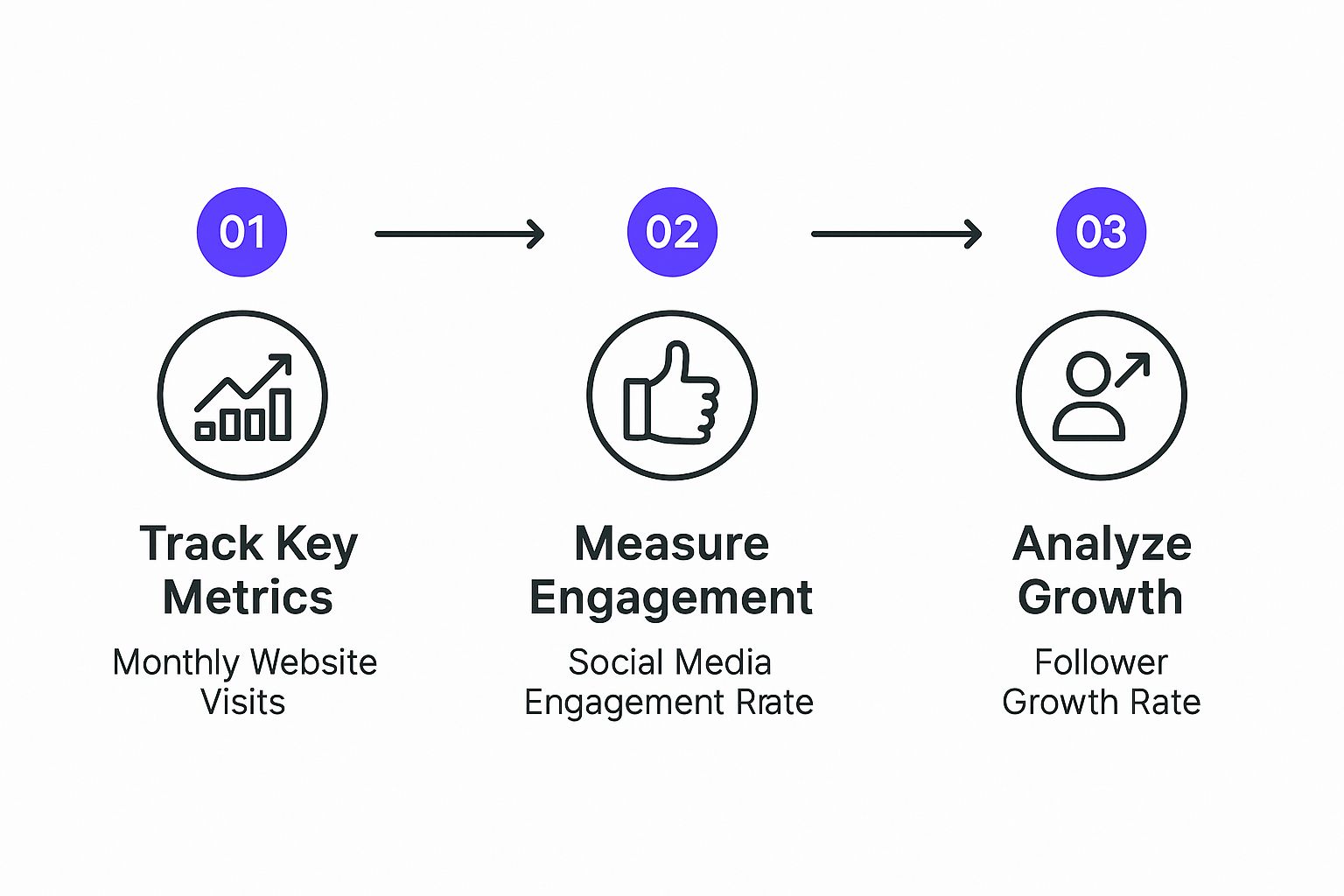
The main takeaway here is to connect your content efforts to real results, moving beyond simple activity metrics to genuine measures of engagement and audience growth.
By following this three-phase plan, you build a sustainable system for growth. Each step builds on the last, turning your initial strategy into a powerful engine that opens up new career opportunities.
Ready to fast-track your action plan? MakerBox uses AI to help you create optimized social media profiles and content in seconds, making it easier than ever to build a standout personal brand.
